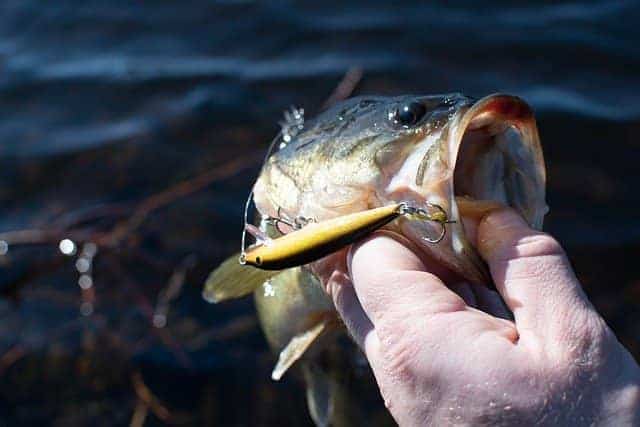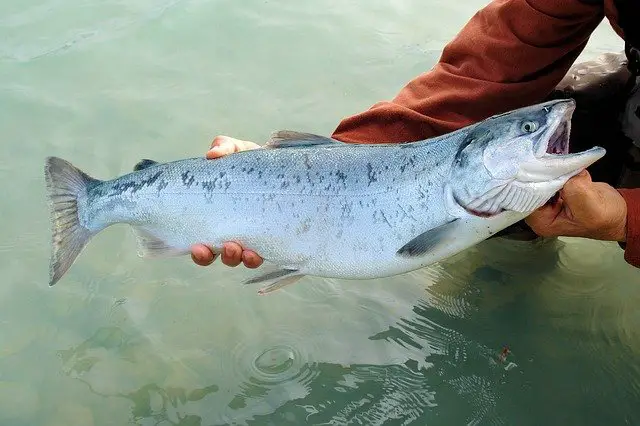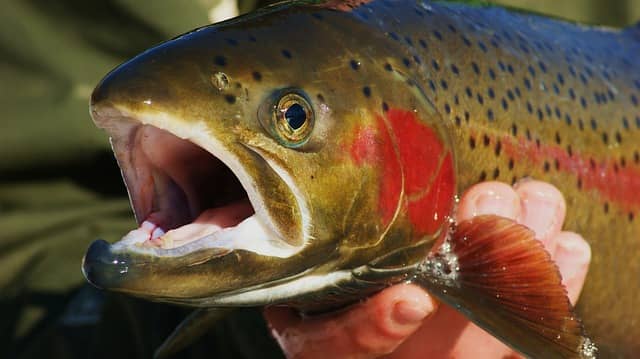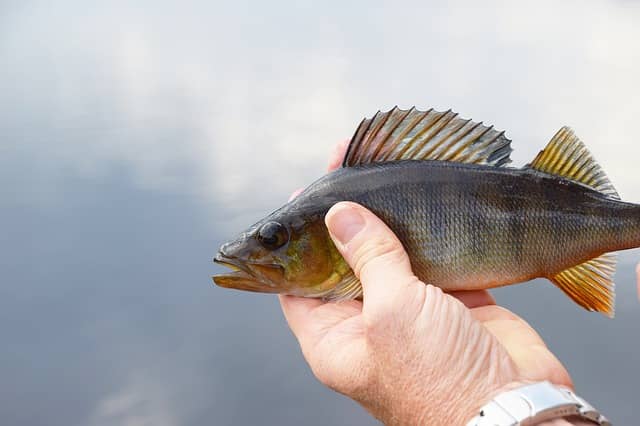Jigging has been in existence for years; however, some anglers still find it challenging to master it. To become a pro and excel in this technique, the first thing you need to do is have the right tackle. With the wrong fishing gear, you will get frustrated and probably not catch any fish.
After getting the right tackle, you just need to slowly learn the technique and the basics like how to cast, where to cast, how to move the rod, and how to introduce the lure. With these tips, you will be touring different waters with much confidence in no time.
What Does the Word Jigging in Fishing Mean?
Jigging is a technique that involves the use of a jig. The term jig in fishing refers to different types of lures. Also, it can be used to describe the movement of a rod tip to depict a life-like motion to the bait or lure. In short, jigging is the act of repeatedly moving the rod tip to portray a lure’s or bait’s movement.
How Does Jigging Fishing Work?
A jig contains a lead sinker and a rubber cover molded around it. Unlike other fishing techniques, Jigging introduces your bait in a vertical motion so that you can target fish found at the bottom. These techniques for jigging fishing include saltwater fishing and shore fishing.
You may also Like : Can you Use a Jigging Rod for bottom Fishing ?
Benefits of Jigging
Jigging fishing has a lot of benefits. For its benefits and versality, it has become one of the most popular fishing techniques.
Effective way of catching fish
Jigging is one of the most successful techniques that will leave you with the biggest catch. It lets you cover more ground and also fish out of sight.
Fun
Jigging is a fun way to spend your leisure time as it’s not tiring, bearing in mind it requires the use of the lightest gear. So, you can be assured of having fun times without ending up completely worn out.
Easy for Beginners
This technique is relatively easy to learn. Beginners and even kids also participate in it, and in a few days, they will have mastered it.
You can use a boat, dingy, or kayak.
Jigging allows you to fish from your kayak, dingy or boat. Most of the time, you do not have to travel far as you can easily fish a few meters offshore.
Drawbacks of Jigging
Expenses
Jigging requires that you get the specific tackle and gear for the application. This makes it quite an expensive technique to feature into.
Time-consuming
This technique is time-consuming as you can wait for several hours before any fish takes a bite or notices your lure.
Prior Knowledge
With this technique, you need to have prior knowledge of the fishing location. Trying out new grounds with most probably prove futile.
Different Jigging Techniques
As we have seen earlier, jigging is the act of repeatedly moving the rod tip to depict a lure’s movement. Therefore, with jigging, you can learn and practice different fishing techniques. These techniques include slow pitch jigging, high-speed jigging, and Overhead jigging.
Slow Pitch Jigging
Slow pitch jigging is a technique that targets fish when they are not actively feeding. Slowpitch jigging differs from regular jigging techniques by how the fish behaves. Therefore, it is essential to note that you are not imitating a fish trying to escape. Here you will be imitating a wounded fish so, only small and precise movements are required. Most fish will not resist this technique making it one of the most rewarding techniques.
High-Speed Jigging
High-speed jigging mainly targets fish that are at mid-level depth. It involves rapidly retrieving a dense spoon up through the water column so that it darts unpredictably. You need a good rod with a slow-action tip with a stout mid-section to thrive in this technique. Also, identify the depth where the fish are holding at and have the right hook and jigs.
Overhead Jigging
The overhead jigging technique is excellent when you are dealing with monster fish. It involves fly casting. Where the weight of the line carries the fly to your intended target. While overhead jigging, pick up and lay down cast with the rod tip low to eliminate any slack. Then, accelerate the line to a crisp stop of 12 o’clock and then to a stop of 2 oclock after which it will form a loop. This loop will help the line fall down slowly into the water.
High Speed vs Slow Pitch Jigging : What’s the Differences
High-speed jigging and slow-pitch jigging are two different jigging techniques that work for different anglers and applications. Below are their differences.
Lure
High-speed jigging usually includes long and thin jigs that will follow a vertical motion even when landing in water. Whereas slow pitch jigs are wider asymmetrical, they have erratic falling patterns as they lay horizontally in water when they fall.
Hooks
Slow pitching hooks are sharp and very fine. Therefore, the hook point grips on your skin when you touch it. They are also smaller since the jig is often attacked during the descent. Their size will vary from 5/0 to 7/0. On the other hand, for high-speed jigging, you need stronger hooks to target bigger fish. The hooks will be chosen in proportion to the size of the jig. The gap should be a little wider than the jig’s width. The hook’s size varies from 7/0 to 13/0
Line
Another difference between the two is the line. Slow pitching hooks mostly use a braided line, and it should be thin to increase the sensitivity and reduce friction during the drag. On the other hand, the line will depend on the fish size and strength when high-speed jigging. The braided line strength usually ranges between 40 to 80lbs. You can also choose to use a fluorocarbon and nylon line, but you’ll need to examine the weight of your lure when picking your fluorocarbon or nylon line. The heavier your lure, the heavier the line.
Technique Difference
When high-speed jigging, the lures are introduced in an upward motion with a rapid, rhythmic pace. In contrast, in slow pace jigging, the jigs are moved with a quick upward lift, and then dropped a short distance as they use up the slackline created by the lift.
Best Types of Jigging Fishing Lures
Lures play a crucial role in fishing. Jigging lures, in this case, will help you attract many predatory species roaming in the deep waters. You can either choose to use jigging worms or jigging spoons. However, when choosing jigging lures, you need to consider the waters you will be fishing from and the fish you are eying so you can choose the right size and color of your lures.
Bigger lures will attract bigger species, and smaller lures are best suited for smaller species. When fishing in clear waters, pale and natural colors work best, while in murky waters or high vegetation waters, bright-colored lures will help attract more fish.
Jigging Worms
Jigging worms are also known as shakey head worms or jig head worms. They are soft plastic lures commonly used in bass fishing.
When using these lures, choose a soft plastic worm and attach it to a jig head. It resembles an actual worm, and it wobbles and wiggles, attracting fish. When using a jigging worm, work it, so it makes some motion as you sink it. However, if you are a beginner reeling in a straight way while making an up and down motion will produce better results.
Jigging Spoons
Jigging spoons are better suited for lake fishing and species like trout. They are made of metal, and they reflect light as they flutter. So you can use them as an alternative to using bright colors.
Many anglers prefer them since as you work the jigging spoons and let them sink, they sink in a flickering back and forward motion. This movement helps attract fish more easily, and they make your fishing easier as you do not have to work much while moving the lure up and down.
Common Jigging Lures
Swim Jigs
Swim jigs are very popular among bass anglers, but they can also be used with other species. They are exceptional due to their unique designs. Swim jigs feature a pointed nose with a vertical line tie to swim through the water column and slip through heavy cover. The line tie is found on the right side of the jig, and it helps ensure a more horizontal motion. These lures produce the best results when dealing with covers such as boat docks or aquatic vegetation.
Grass Jigs
Grass jigs are pretty versatile and can be used for different presentations. However, they excel at fishing the green stuff. They fall within the weight range of ¼ to 11/2 ounces. The design includes a conical head with a line tie near the top. This design allows them to spear through the grass without collecting grass. The jigs should be compact with few attachments to avoid collecting grass. Additionally, they should be paired with a heavy wire hook since they work excellently on heavy tackle.
Casting Jigs
Casting jigs feature a round Arkie style or flat-bottom head to help stand off the bottom. They are ideal for different fishing applications, and they can be fished with or without a rattle. Moreover, they work best with a wire weed guard of medium strength. Some of the best casting jigs trailers include craws, creatures, and grubs.
Flipping Jigs
Flipping jigs are perfect when fishing under heavy vegetation. They will get in the heaviest bush and come out intact. Their weight range falls between 3/8 to 1 ounce plus a heavy solid gauge hook. Additionally, they have a compact head shape with a recessed line tie. Their weed guard is also firm to prevent hanging up of the jig.
Football Jigs
Football jigs are meant to be dragged along rocky bottoms. They are designed with a pigskin-shaped head to roll over rock and rubble without falling into the cracks. The head should weigh somewhere in between 3/8 to 1 ounce, and they should have a fuller skirt and a sharp wide gap hook. Football jigs also come with weed guards; you can choose to keep yours or trim them if you are fishing in open waters or looser cover areas.
Finesse Jigs
Finesse jigs are best suited for smaller fish and in cold areas. Their weight range is usually between 3/16 to ¼ ounces. Mostly, they come with finesse spider cut skirts and a finesse light wire hook. The head should be compact with a ball shape, and when paired with small craw and creature baits, they give the best results.
Jigging in Different Water Conditions
Jigging is an application that can be used in different water conditions and techniques. That’s why it’s used in freshwater, saltwater or even ice fishing.
Saltwater Jigging
Jigging thrives quite well in saltwater. The reason is, in saltwater, you will find all fish species and especially the biggest species. There is no better technique to use with bigger fish species than jigging. Don’t let the name confuse you. You can use this technique even in freshwater. Basically, saltwater fishing involves casting and reeling the jigging lure in an up and down motion. It’s common in larger waters and open areas.
Shore Jigging
Shore jigging can be described as fishing from the shore. You could be standing on a cliff or rock where you can position your lure underneath your rod. However, this technique requires finding a suitable location and creating an energetic jig action that will attract fish.
When casting, ensure the lure hits the bottom and from there, start making small movements with the wrist of your hand. You can try up, down, and side movements. Additionally, you can twitch up the lure slow or fast to work it. Then position your jig at the bottom, work it up about one-third of a way up, and let it sink again. This attracts a particular motion that attracts fish like Walleye, Snappers, and Bluefish.
Freshwater Jigging
Jigging in freshwater is also very common. The technique required is similar to that used in saltwater jigging. However, you need practice for better results. Make sure your jigging combos are lightweight. For the line, a braided line is more preferred as it does not stretch like other lines.
Jigging for Ice Fishing

As we have said earlier, jig fishing can be used in different techniques. However, to master this technique, you need to be extra careful. Firstly, drop your line and let your jig hook sink to the bottom. Next, slowly raise your bait about a foot off the bottom and move the lure up, down and sideways. But, make sure you do not move the lure too fast as some fish will not find it worthy of going after it.
Jigging For Different Fish Species
Anglers who have used jigging techniques can assure you that this is one of the most versatile techniques. This technique was not in existence for years, but it has become one of the most used and trusted techniques since its invention. Its popularity tells it all. So whether you are eying saltwater species or freshwater species, you can be confident if you will be using jigs. You need to ensure you have the right combo, lure size, and understand the different techniques. Here are some you can use jigging techniques on.
Jigging for Bass

Bass are very popular; any serious angler has come across one or two. Jigging bass has been around for years, and this technique rates as one of the best in producing excellent results. When jig fishing for bass, first make sure you use multi-coloured jigs. Also, make sure you are using the most sensitive rod or use a line watcher as you can easily miss the bites and hits of brass. Additionally, the trailer will determine your success; therefore, choose the best trailer for your application.
Jigging for Salmon

Jigging for salmon is slowly gaining popularity. It’s especially common in the summertime, and as summer progresses, salmon move into shallow waters and close to the shore. When jigging for salmon, you need to ensure you have the fishing spot right, have the right technique and the right gear. Mainly the reel, ensure the reel lets the lure freely flutter as it falls.
Jigging for Trout

Jigging for trout involves using light gear. Jigging for trout is more prevalent in freshwaters; also, it is very effective during the winter season. In this technique, you will be using traditional trout flies on droppers with a small sinker attached at the bottom.
Jigging for Walleye
Jigging for Walleye is a prevalent technique for anglers who enjoy fishing in rivers. Its best carried out in the springtime requires you to sit on the boat with your walleye rod suspended with a 3/8 ounce jig head.
Jigging for Perch

The basic rule of jigging for perch is to introduce a lure that swims the whole time and follows a path that looks like a long series of flattened, joined-up ‘mmmmmmmmmmmm’ with the paddle tail lures while swimming, creating a very attractive action that makes it easy to attract perch.
Jigging Tackle : What do you need for jigging?
Like any other fishing technique, you need to be very careful when choosing a jigging tackle. The rod, reel, line, leader and tackle will ensure the success of your fishing adventure. Jigging tackle is purposely designed for jigging techniques, and the use of other tackles for this technique might leave you disappointed.
Rod
The rod is probably the most essential item when fishing. In jigging, you need the rods specialized for this application. Jigging rods are designed for jigging specific weights and designs. These rods are split into two: the parabolic action rod used in the Taiwanese jigging and technical jigging rods used in the Japanese jigging style.
The Japanese style has a specialized tip section and mid-section, offering better lifting and recovery capabilities than parabolic action rods. You need to consider certain things in a jigging rod including the tip, mid and butt section, and grip and reel seat position.
The tip section of the rod is essential in jigging. A very soft tip won’t maintain an upward motion of the jigging action, making the rod unresponsive. Similarly, if the rod is too stiff, it will not work the jig well, making it hard to keep up a good jigging rhythm.
The mid and butt section provides the power and lifts needed to lift the fish when it’s hooked. The grip and reel seat positions, on the other hand, ensure maximum comfort for long hours of fishing.
Reel
Jigging reels have been advancing over the years. Manufacturers are working towards ensuring maximum performance and jigging success. When choosing a reel for jigging, you need to look at the spool’s width, gear ratio, drag capacity, and reel size.
The reel’s spool should be narrow, as it helps eliminate sideways wobble when cranking the reel; it should also be light.
The next factor is the drag, and a reel needs to have a high drag capacity of between 10 to 20kgs to help stop hard-pulling fish. Additionally, a gear ratio of 4.1:1 to 6.2:1 will work perfectly for jigging applications.
Line
The line is also very crucial in any fishing experience. Braid is the most preferred line for this application, but you can also go for fluorocarbon or nylon lines if they work for you. Braids are preferred as they have no stretch, allowing anglers to stay in touch with the jig.
When choosing a line for jigging, you need to consider its breaking weight strain. Always ensure the line you choose can handle the strain involved in jigging, and I would also recommend using a multi-coloured braid since it makes it easy to determine the used line.
Leader
Different anglers have varying priorities when it comes to the leader. The leader can either be mono or fluorocarbon. Mono is easier to tie, has a better knot strength and is less brittle. Fluorocarbon, on the other hand, is invisible in water, and it’s also abrasion-resistant.
The recommended leader of over 45kgs with length ranges of 4m to 7m works ideally in jigging. However, you need to replace the leader after every trip.
Jigs
Jigs are made of different sizes and shapes. When choosing the right jig for your technique, you need to consider the jig’s weight and size. A jig that is too light or heavy will not produce the desired results. The different designs, shapes and weights have been designed to fit different rods. To make work easier, manufacturers have the weight range indicated on the rods to make purchases easier. Also, consider the jigs color when making your purchase. Bright colors are better suited when fishing in heavy cover areas, while dull colors work better in open grounds.
Jigging Setup
Whether you are a beginner or veteran, this jigging set up will help you improve your angling skills and make jigging an effortless technique.
- The first step is to cast out and let your jig hook sink to the bottom and wait a few minutes until you feel the spoon hit the bottom.
- Secondly, snap your wrist and rod tip up quickly for a short distance and let the lure drop back to the bottom.
- Then, jig up and down and sideways.
- Finally, reel up a little bit to ensure the line is tight enough so that you can increase its sensitivity. This way you will feel the fish strike or move.
Frequently Asked Questions
Can you fish Jigs in deep water?
Jigging is a technique that works in different waters and helps in catching different species. Jigging excels in deep water as it involves introducing the jig in a vertical motion to reach the bottom parts attracting fish found in the deepest parts.
Can you do Jigging at Night?
Jigging at night yields marvelous results. With it, you can dissect cover keenly for your catch. However, the best place for jigging at night is along the bluff walls, ditches and brush. Use dark colors and bulky trailers to enhance the best results.
Why is it called jigging?
This technique is referred to as jigging as it is a practice of fishing that uses a jig. A jig is a lure consisting of a lead sinker, with a hook moulded into it and it creates a jerky, vertical motion so you can attract fish even when they are not feeding.
What is Jigging used for?
Jigging is used to catch different fish species, including bass, trout, walleye, salmon and perch. It can be used in different waters including, saltwater, freshwater and even in ice fishing. Jigging is also used in different techniques, including shore fishing, slow pitch, and high-speed jigging, among others.
Final Impression
Jigging is one of the most successful fishing techniques and it’s still very easy to learn. Therefore, if you are looking for a way to spend your time you can try jigging and the different techniques involved in jigging fishing lets you enjoy fishing in different seasons. You do not have to be a pro just get the right gear and in a few days you will be matching out of the water with a few catches.
